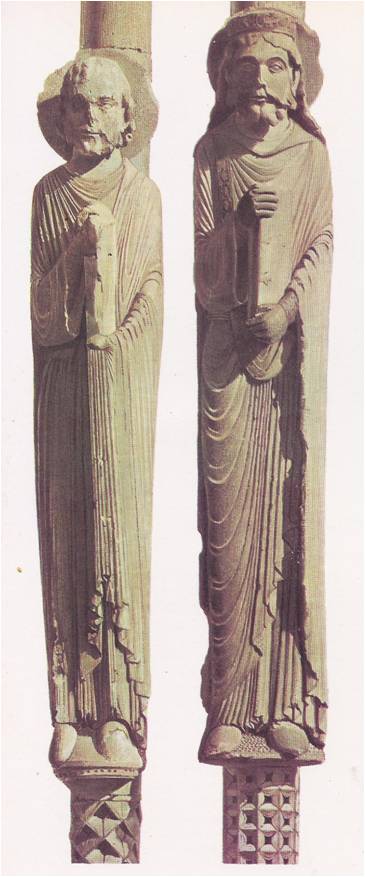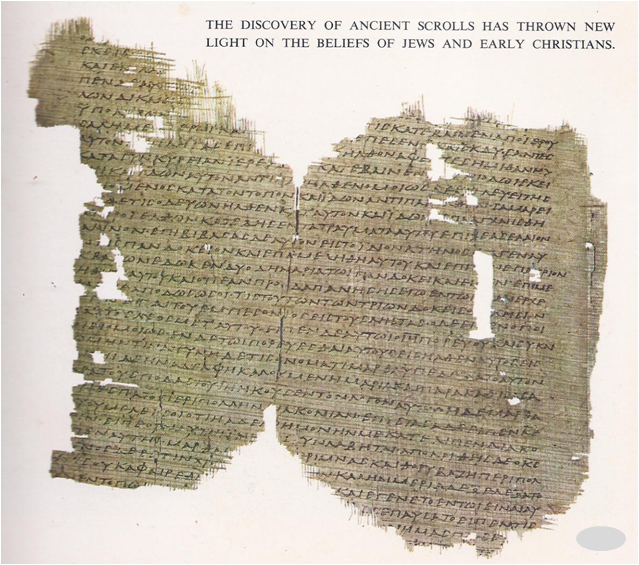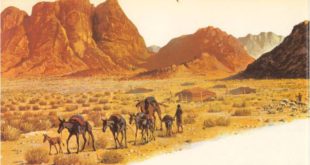IN 1518, AN INDULGENCE PEDDLER, a priest from France, made his way through one of the twisting Alpine passes that led into Switzerland. He carried with him a supply of bright banners, an impressive-looking copy of Pope Leo’s Declaration of Indulgences and of course, a collecting box. The French priest’s hopes were high, for the little Swiss merchant towns were rich. He did indeed do well at first and his collecting box began to grow heavy with pieces of gold. Then he came to the town of Zurich. As he began to set up his banners, a town official stopped him. “No indulgences here,” the official said. “I come in the name of Pope Leo and the Holy Church,” the Frenchman replied. “And I,” said the official, “speak for the town council of Zurich and the People’s Priest of our Cathedral who has told us that these indulgences you peddle are no good.” When the Frenchman began to protest, the official said he would have him driven out of town if he didn’t leave peacefully. The Frenchman rolled up his bright banners and went on his way. The Swiss, he knew‚ had always been too independent and now, with this People’s Priest, whoever he was, they seemed to have found another Martin Luther. Actually, nothing so annoyed the People’s Priest of Zurich as being called the “other Luther.” Ulrich Zwingli said that his ideas were his own and that he had come upon them long before Luther began to make a stir in Wittenberg. As a young parish priest‚ fresh from the university, Zwingli had studied Greek and Hebrew in order to read the Bible and other early church writings in their original languages. Three times he had gone to Italy, as chaplain to the rugged Swiss soldiers who were …
Read More »The Power of the Church 529 – 1409
IN THE YEAR 1134, in the town of Chartres in France, the church burned down. The church was a cathedral — that is, it was the church of a bishop. The bishop at that time was Theodoric and he immediately began the construction of another cathedral. He knew that the task would not be an easy one; it meant raising large sums of money and finding many workmen and the actual work of building would take years. Bishop Theodoric allowed nothing to stop him, he won the support of the people, of commoners and nobles alike. An eye-witness, who visited Chartres in 1144, wrote that “kings, princes, mighty men of the world, puffed up with honours and riches, men and women of noble birth,” helped in the work, pulling wagons loaded with “wine, corn, oil, lime, stones, beams and other things necessary to sustain life or build churches. . . .” Although a thousand men and women were drawing wagons, “yet they go forward in such silence that no voice, no murmur, is heard. . . When they pause on the way no words are heard but confessions of guilt, with supplications and pure prayer. . . . The priests preach peace, hatred is soothed, discord is driven away, debts are forgiven, unity is restored.” The cathedral was complete in 1180, but fourteen years later a fire broke out again, destroying most of the building. It also destroyed the towns people’s houses. They would have given up both the church and the town if it had not been for a representative of the pope. The fire was God’s punishment for their sins, he warned, and now they must restore the cathedral and put up new houses. The towns people did as he said. Money for the rebuilding of the church …
Read More »Great Church Fathers A.D. 340-430
IT WAS about the middle of Lent in Antioch, reported Jerome, when “a deep-seated fever fell upon my weakened body, and . . . it so wasted my unhappy frame that scarcely anything was left of me but skin and bone. Meanwhile, preparations for my funeral went on; my body grew gradually colder and the warmth of life lingered only in my throbbing breast. Suddenly I was caught up in the spirit and dragged before the judgment-seat . . .” Then follows a long account of his dream in which Christ scolded him for his devotion to the works of the Roman writer Cicero. In his dream Jerome took an oath that he would never again read a worldly book. “Thenceforth I read the books of God with a zeal greater than I had previously given to the books of men . . .” That was the turning point in the life of Jerome, who went on to become the most outstanding scholar of the ancient western church. JEROME THE SCHOLAR Jerome was born of well-to-do Christian parents about 340. He studied in Rome, where he was baptized at the age of twenty. His brilliant mind and restless energy drove him to explore religion and the classics. From 366 to 370 he traveled about in Gaul from city to city. Later he traveled through the eastern part of the empire. In Antioch he became seriously ill and had the famous dream in which Christ lectured to him. The dream must have been very real to him. As soon as he was well enough, he went into the Syrian desert and lived there as a hermit for six years. Then he returned to Antioch to become a priest. He continued his studies in Constantinople. In 382 he went to Rome and …
Read More »The Resurrection and the Faithful Few A. D. 29 – 35
JESUS lived and died a Jew. Like the ancient Hebrew teachers, he urged people to love God and to love their neighbours. He left no writings of his own. His public ministry was short, possibly not as long as two years. It seems probable, therefore, that his influence on world history might not have been nearly as great had his story ended on the cross. The gospel story does not end with his crucifixion. He died on Friday. To speed the death of those crucified on Fridays, so that they could be buried before the Sabbath, the legs of the victims were usually broken. The soldiers broke the legs of the thieves hanging on either side of Jesus. But since Jesus seemed to be dead already they did not break his legs. To make certain he was dead one of the soldiers thrust his spear into the side of Jesus. One Joseph of Arimathea received permission from Pilate to take away the body of Jesus. This he did with the help of friends and placed the body, in a new sepulcher in a nearby garden. The grave was really a cave hollowed out of rock in the side of a hill. Over the entrance they rolled a huge stone. The following day being the Sabbath, nothing more could be done. Early Sunday morning, Mary Magdalene and other followers of Jesus brought sweet spices to anoint his body. But they found the stone rolled away and the tomb empty. Puzzled and frightened, the others left the place, but Mary did not leave. While she was weeping by the side of the tomb Jesus suddenly appeared before her. That same evening in Jerusalem, Jesus appeared before a number of disciples gathered together in a locked room. The disciples were terrified, for they …
Read More »The Life of Jesus Christ (B. C. 6 to 29 A. D.)
ALL THAT is known about Jesus of Nazareth appears in the first four books of the New Testament. These books, written many years after his death, are called the gospels of Matthew, Mark, Luke and John. There are differences of detail in each and the events of his life are not always reported in only one or two of the books, others in all of them. The gospels of Matthew and Luke, for example, begin with the birth of Jesus to a virgin named Mary. The gospels of Mark and John begin with events that took place some thirty years later. In general, the life story of Jesus is the same in all four gospels. Jesus was born in Bethlehem of Judea in the days of King Herod, probably about 6 B.C. Almost nothing is said of his childhood, except that he lived in a village called Nazareth in the province of Galilee with his mother Mary and her husband Joseph. Joseph was a carpenter. As a boy, Jesus probably served as his helper and became skilled in making such things as yokes for oxen, bins, chests, beds and kneading troughs. In his home, Jesus spoke the common language of the Jews, which was Aramaic. The synagogue served both as his school and as his place of worship. There he studied the Scriptures and probably learned his prayers in the ancient Hebrew tongue. We are told that during his youth he “increased in wisdom and in stature, and in favour with God and man.” Jesus was thirty years old when John the Baptist began preaching in the valley of the Jordan near the Dead Sea. John was believed to be a prophet. From Galilee and from all the other provinces of Palestine, people came in large numbers to hear him. …
Read More »The People of One God 3000 B. C. – 30 B. C.
On the plains of Mesopotamia, a young man stood gazing up at the stars that glittered from the dark sky of night. He was Abraham, a native of the Sumerian city of Ur. Abraham was a Hebrew, one of the many tribes of Semites said to have been descended from Shem, the son of Noah who had been saved from a great flood many years before. Like all people of his time, Abraham believed in many gods throughout nature. As he studied the pattern of the great stars for the god’s message, Abraham began to feel he was in the presence of a Lord God who was above all gods with idols and temples and sacrifices. Abraham felt, too, that this Lord God would take special care of those who lived up to his demands. Abraham became so devoted to this idea that years later he was inspired to leave Mesopotamia and start a new nation whose people would worship only the Lord God. With his family and tents and flocks, he made his way westward to the land of Canaan. After many setbacks, Abraham died there, content to know that his son Isaac would carry on the family. Isaac prospered and was followed by his son Jacob, whose life was such a struggle that he was honoured with the name Israel, meaning “struggler of god”. Jacob had twelve sons, each of whom founded a tribe and they and all their descendants became known as Israelites. One of Jacob’s sons, Joseph, became an important official in the Egyptian court and when a famine in the land of Canaan threatened to wipe out the Hebrews, they all joined Joseph in Egypt. This was the story told in the Bible and the traditions of the people who honoured Abraham, Isaac and Jacob …
Read More »





